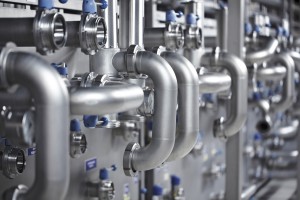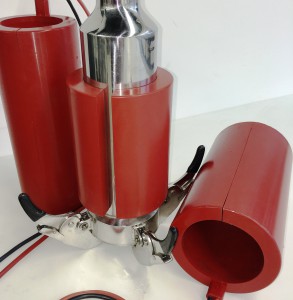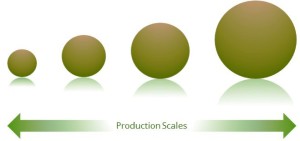Heating Jackets for Water for Injection (WFI) and High Purity Water (HPW) Filtration Processes
Filtration is essential in many different processes throughout almost every industry in terms of separation and prevention. Filtration is critical to the process and the quality of the product. When using water for injection in production of food, beverages or pharmaceuticals the focus is on process stability and prevention of downtime. The good manufacturing practice (GMP or cGMP) and Federal Drug Administration (FDA) guidelines set standards in terms of design and inspection of WFI and HPW systems. When it comes to filtration processes, the vent filters, installed in line of the system, play an important role during phases of design and inspection. The vent filter is an essential component, which the following paragraph by the FDA describes:
“The one component of the holding tank that generates the most discussion is the vent filter. It is expected that there be some program for integrity testing this filter to assure that it is intact. Typically, filters are now jacketed to prevent condensate or water from blocking the hydrophobic vent filter. If this occurs (the vent filter becomes blocked), possibly either the filter will rupture or the tank will collapse.”
Most common in rigid stainless steel systems for food, beverage and pharmaceutical production are steam jacketed vent filter housings. A good and reliable solution, but in terms of investment and installation, steam jacketed systems are costly. It is also very time consuming during replacement sessions of the inner filter cartridges. At the end, these systems are not very flexible once installed in a production process.
One alternative that provides easy handling and replacement are electrical vent filter heating jackets. They provide a maximum on safety with accurate temperature control and are easy to install on the vent filter housing. One may say that electrical heaters are a potential hazard and are not suitable for use in such environments, but these heating jackets are of unique design to fit exactly those stringent requirements.
The one-piece molded design is formed out of a two-component silicone rubber compound that fits around the filter housings without any fixation methods that may be not compliant for use in those production processes. The design provides a high level on ingress protection safety and is fully functional even 24 hours after submerging into potable water. The construction also focuses on minimizing potential voids to prevent formation of residue and microbes. By using only silicone rubber compounds for the complete design one benefit is that the complete heating jacket can be easily cleaned with most common detergents used for cleaning WFI and HPW systems.
A second advantage is that the silicone rubber heating jackets are following latest EHEDG and 3-A Sanitary standards for food production processes. Finally, they pass FDA and BfR specifications concerning silicone rubber materials and all components pass latest RoHS and REACH requirements.
Different Scales of Production for Biopharmaceutical Applications and Processes
More benefits of the electrical heating jackets arise when we move towards latest biopharmaceutical applications. In recent years, there has been an increasing demand for single use technologies in different scales of production. From prototyping, through tabletop applications all the way up to large reactor systems, these processes also require high purity water injection that use special vent filters. The vent filters used for single use systems are typically made of polymers instead of stainless steel design. Diversity in design, shape and size make it inapplicable to use steam jacketing. Since the same regulations apply for any WFI system, those filters need to be heat traced in order to prevent dew formation inside and clogging of the lines. Electrical heating jackets provide the one alternative for any production scale whilst remaining all benefits in regards to safety and necessary design requirements.



